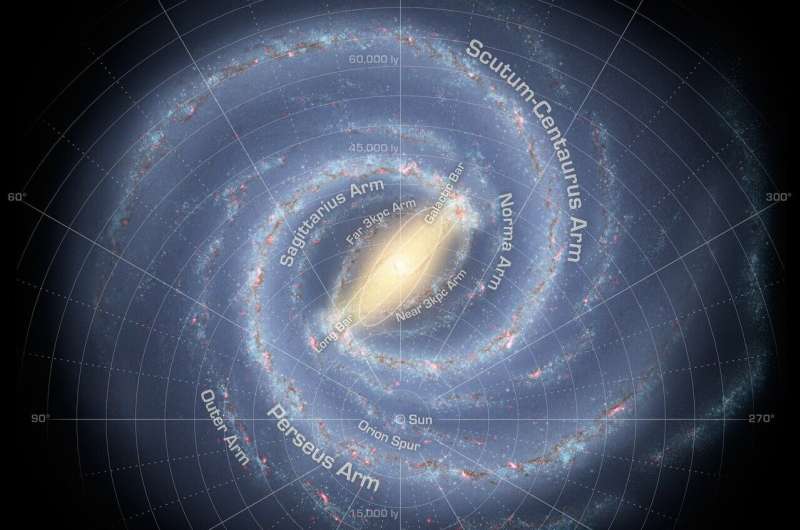Matching Orphaned Stars to Their Origins in the Milky Way through 'Stellar Paternity Tests'

January 10, 2024
The following content has been assessed under the editorial policies and process of Science X, focusing on the following criteria for ensuring credibility:
- It has been fact-checked
- Reliable sources have been referenced
- It has been proofread
Review conducted by Amy White from Lehigh University
Strong gravitational pulls among celestial bodies within open star clusters can hurl individual stars beyond the limits of these clusters or even outside the Milky Way galaxy. For the first time, scientists have mapped some of these extragalactic stars back to their origination clusters, utilizing the latest data from the Gaia Mission of the European Space Agency.
The research study titled 'Stellar Paternity Tests: Matching High-Latitude B Stars to the Open Clusters of Their Birth' was introduced during a press conference at the 243rd meeting of the American Astronomical Society (AAS) in New Orleans by a team of research scholars from Lehigh University.
M. Virginia McSwain, associate professor of physics at Lehigh University, stated: 'Through the process of tracing these stars back in time, we've managed to connect 15 of them to the star clusters in which they were born. This offers us more knowledge about the history of the Milky Way’s star clusters.'
The stars that astronomers observe outside the flat disk of the Milky Way galaxy, which contains the spiral arms and is thicker at the center, are more than eight billion years of age. As they were formed early in the galaxy's history, it seems plausible that they have drifted considerably from their birthplaces.
Since the majority of the star formation within our galaxy occurs on its thin disk, finding B-type hot stars outside this region is rare. A small number of these relatively young stars – nearly 10 to 100 million years old – are detected at high altitudes, presumably having been ejected from their birth clusters some millions of years ago.
Brandon Schweers, a Lehigh University undergraduate student who contributed notably to this research, explains 'Hot stars typically remain within the disk, and when they leave it, they are noticeably out of context. Most of these B-type stars were probably expelled from their 'parent' clusters due to three or four body gravitational interactions, propelling them away from the Milky Way.'
One of the stars studied was observed to have been expelled at a significantly high speed, suggesting an ejection triggered by a supernova in a closely linked binary star system.
These 'orphan' stars have been known for nearly two decades. However, tracing them back to their original star clusters wasn't possible earlier due to the unavailability of requisite data. The Gaia Mission has now provided researchers with data that helps decipher the stars' motions with more precision than before.
The Gaia Mission, launched in 2013, aims to create an accurate three-dimensional map of the Milky Way by surveying more than one billion of its stars. It includes unrivalled positional and radial velocity measurements for the brightest 150 million objects.
Utilizing the data supplied by the Gaia Mission in 2022, researchers from Lehigh trace the kinematic trajectories of 1,400 known galactic open clusters and 95 high-latitude B stars. This tracing aims to identify moments of possible intersection and subsequent ejection in the past.
Associate Professor McSwain adds that the initial identification of prospective matches was followed by comparing each ejected star's color and brightness to that of the cluster stars on the Hertzsprung-Russell (H-R) diagram. Open clusters consist of thousands of stars of the same distance, age and composition.
According to McSwain, the shape of an H-R diagram is mainly dependent on the open cluster's age, which allows them to verify if an ejected star is of similar age to its probable siblings within the cluster.
By applying the H-R test, the researchers were able to narrow down the list of potential matches further. Lastly, they analyzed the core densities of each cluster that might be a match. Clusters with a higher density provide higher probability of strong gravitational interactions, leading to the ejection of stars.
Combining these tools, the researchers confirmed positive paternity matches for 15 orphaned stars. That galactic genealogical tracing was what gave Schweers the idea for the presentation's title.
'When I reached the stage of comparing the color and brightness for the potential matches and discarding those that showed a poor correlation in the H-R diagrams, I felt as though I was comparing the 'DNA' of the orphaned stars and their potential siblings,' Schweers said, reminding him of 'The Maury Povich Show.'
'I think everyone has heard the saying, 'You are not the father' that came from that show. For many of these clusters, I was essentially telling them they are not the parent of these orphaned stars, so I came up with the name 'Stellar Paternity Tests,'' he said.
Based on their trajectory calculations, the researchers estimate the ejections took place about 5 to 30 million years ago, 'flinging abandoned stars across the Milky Way at speeds of 30-220 kilometers/second (67,000-490,000 miles/hour) to their present locations,' they wrote. 'Our results provide a measure of the ejection age for each orphaned star, providing new insight into the relative importance of dynamical vs. supernovae ejection in young open clusters.'
While they were able to match a number of the far-flung stars, some couldn't be traced back to the Milky Way's disk very plausibly, which may provide evidence for other unusual scenarios, they added. These might include rare star formation in molecular clouds high outside the disk, or they could be relics of past dwarf galaxies that merged with the Milky Way in the past.
Undergraduate astrophysics student Christopher J. Aviles Bramer, who graduated in 2022, contributed to the research project.
Provided by Lehigh University




